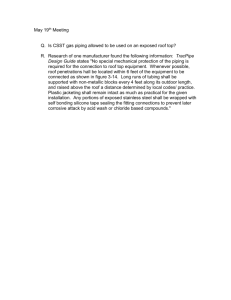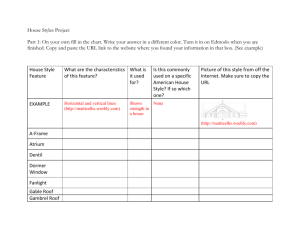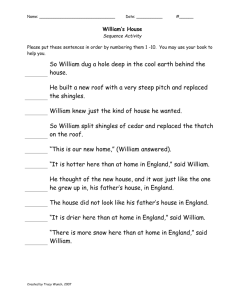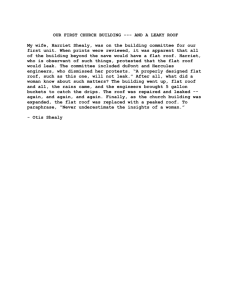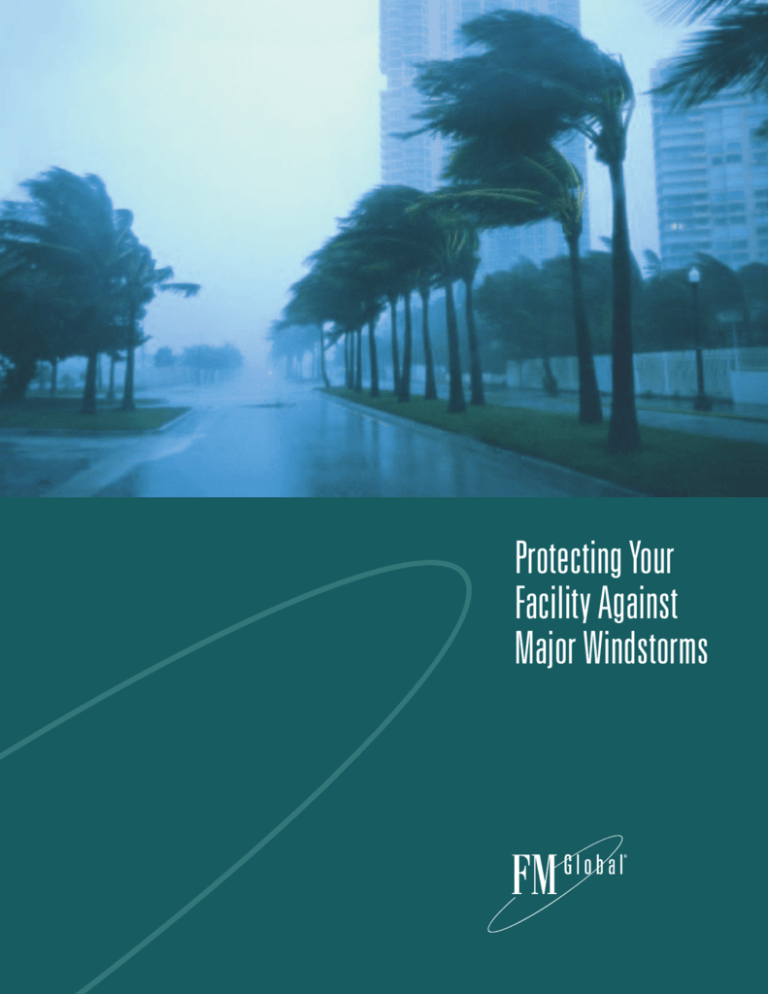
Protecting Your
Facility Against
Major Windstorms
This brochure is made available for informational purposes only in support of the insurance relationship between FM Global and its clients.
This information does not change or supplement policy terms or conditions. The liability of FM Global is limited to that contained in its insurance policies.
ver the many years that FM Global
has analyzed windstorm damage
to buildings, including damage
caused by severe windstorms in the
past decade or so, one fact is clear:
Buildings designed, built and maintained according to FM Global’s
recommended guidelines have withstood high winds with minimal damage. Significant loss has been limited
mostly to buildings that did not meet
FM Global standards. Another factor:
FM Global guidelines are likely to
exceed the requirements of local
building codes.
O
By Any Name,
A Formidable Hazard
No peril can match that of a severe
windstorm in its ability to cause
widespread devastation. Such storms
include hurricanes, typhoons and
cyclones—depending on the part of
the world they affect—and their fierce
winds have been among the most
significant contributors to FM Global
client losses, for an annual average
of US$210 million gross in the last
25 years. Ten percent of all damage
sustained by FM Global clients during
this period was related to wind.
1
Saffir-Simpson Scale
3-Second Gust Wind Speed
187 mph (301 kph)
158 mph (254 kph)
133 mph (214 kph)
115 mph (185 kph)
88 mph (142 kph)
60-Second Mean Wind Speed
CAT 5
CAT 4
CAT 3
CAT 2
CAT 1
Approximately 50 percent of these
losses resulted from severe hurricanes
and tropical storms, including the four
significant hurricanes that struck
Florida, USA, in 2004—an industry
record-breaking hurricane season. With
proper knowledge and preparation,
however, you can minimize extensive
wind damage and the risk it represents
to your business—even in the most
severe storms.
Understanding Wind
Before you can secure your facility
against the impact of windstorms,
you would do well to arm yourself
with information about wind in
general. The following sections
offer some background.
Speed and Force
As wind speed increases, the wind’s
force accelerates rapidly. For example,
a constant breeze of 20 mph (32 kph)
exerts a pressure of 1 psf (48 Pa).
2
Improvements Needed
156 mph (251 kph)
Catastrophic
FM Global
Recommendations Followed
Extreme
Extensive
Extreme
131 mph (211 kph)
Extensive
111 mph (179 kph)
Moderate
96 mph (154 kph)
Moderate
Minimal
Negligible
Minimal
74 mph (119 kph)
When wind speed is increased four
times to 80 mph (129 kph), pressure
increases 16 times to about 16 psf
(766 Pa). The stronger winds from
a hurricane, combined with gusting
effects and the extra force at the roof
perimeter and corners, cause pressure
to quickly multiply.
Remember that wind speeds are not
necessarily uniform over a given area.
If you think you’ve survived a major
hurricane, find out the top wind speed
at your facility. The diameter of the
damaging winds of a hurricane,
typhoon or cyclone is typically 50 to
100 miles (100 to 200 km), with the
storm area from 100 to 300 miles wide
(200 to 500 km). Within these areas,
the wind speeds vary significantly, with
the most intense and damaging winds
usually within 30 miles (48 km) of the
eye and concentrated at an area known
as the Radius of Maximum Winds
(RMW). As a result, the range reported
at a local weather station may be differ-
ent from the speed at your facility, so if
a Category 4 hurricane strikes your
area, your facility may experience only
Category 1 winds.
Direction
Tropical cyclones spin around a central
low-pressure core, with the direction
of circulation governed by the rotation
of the earth. Storms in the Northern
Hemisphere spin counterclockwise,
and storms in the Southern Hemisphere
spin clockwise. In the Northern
Hemisphere, the winds on the eastern
side of the storm are typically
strongest, whereas the western side
of the storm presents the strongest
winds in the Southern Hemisphere.
Intensity
It is important to know which basis
is being applied in reports on the
intensity of a windstorm. Wind speed
can be measured by various averaging
times, such as the three-second gust
and 60-second mean. The comparison
in the Saffir-Simpson Hurricane
Intensity Chart at left shows the
relationship between these two
measurements. For example, a wind
speed at the threshold of a Category 3
hurricane is 133 mph (214 kph) by
the three-second gust wind speed
compared with 111 mph (179 kph)
by the 60-second mean wind speed.
Loss Prevention Guidelines
Vulnerable Locations
Buildings located next to open terrain,
where the wind can blow unimpeded—
such as near fields, large bodies of
water, parking lots and airport runways—are likely to be damaged
when the wind strikes with full force.
FM Global testing and modeling have
shown that wind also can accelerate
around hills, berms and escarpments.
Recommendations:
The location of a facility is dictated
primarily by availability, costs and
business strategy. Where possible,
choose a built-up area, away from
flat, unobstructed terrain. FM Global
engineers can help you factor in ground
roughness as you determine how much
wind resistance you need for a new
or renovated building.
Vulnerable Occupancies
FM Global has found that, at
some facilities, rain entering the
building—not wind striking it—
accounted for most of the damage.
Rain pouring in through the roof
or broken windows will damage
products, metallic surfaces prone
to rust, electronic instrumentation
and chemicals. Items stored directly
on the floor are especially vulnerable.
Recommendations:
Place extra emphasis on a properly
designed and maintained building,
especially the roof, according to
FM Global Property Loss Prevention
Data Sheets and the Approval Guide,
a publication of FM Approvals. Store
products off the floor on pallets, and
keep ample waterproof tarpaulins on
hand to cover vulnerable equipment,
material in process and finished goods.
Design and Installation Deficiencies
Most design and installation
deficiencies are in the roof, leading
to problems with flashing, roof
covering, insulation and even the
deck itself. Such deficiencies allow
rainwater to enter buildings and
destroy equipment, furnishings and
interior finish. Frequent damage
has been the result of unreinforced
masonry parapet walls and decorative
facades; these structures can blow
over and destroy the rooftop or
anything else they strike.
Recommendations:
Follow recommended design and
installation guidelines in the data
sheets, select products from the
Approval Guide, and ask your
FM Global engineer to review
construction plans. Avoid unreinforced
parapets and decorative facades.
Also, consider replacing roofs that
are nearing the end of their service
life or have known deficiencies.
During construction projects, closely
monitor contractors to ensure product
selection and installation follow your
original specifications.
Glass Windows and Other Openings
Glass wall panels and plate-glass
windows are vulnerable to breakage
by wind-borne debris and the direct
force of wind. Tree branches, outdoor
furniture, building materials, gravel and
roof tiles can become missiles that will
break glass. If a large opening results,
wind and soaking rain will cause significant damage in the building. In
coastal areas, wind-driven saltwater
spray may cause additional damage to
sensitive equipment. In locations with
a year-round warm climate, buildings
with open sides, windows and doorways will be more vulnerable to damage by high winds and rain. Unless
the facility is promptly secured after
a storm, broken windows at ground
level also will provide easy access
for looting and vandalism.
Recommendations:
Before a storm, remove outdoor
furniture, trash containers and other
relatively lightweight objects that could
become windblown missiles. Shield
windows with hurricane shutters or
plywood. Close and latch exterior
doors and windows, and brace large
doors at shipping and receiving docks.
Indoors, relocate equipment away from
windows, where practical, or cover it
with waterproof tarpaulins. If smaller
items are on the floor, place them on
pallets, racks or shelving.
3
This glass wall facade was destroyed by high winds,
leaving the building interior vulnerable to wind and
rain damage.
The damaged roof covering on this seaport building
is mostly along the edge, where wind forces are at
a maximum.
An inadequately designed parapet wall with masonry
blocks was blown off at the roof line.
Consider replacing large windows
with smaller ones, filling the remainder
of the window space with wall
construction equal to the rest of the
building. Replace standard glass
windows with a laminated glazing
system that meets test criteria for
missile resistance. In new buildings,
increase use of blank wall construction
and narrow profile windows.
When a hurricane is approaching,
latch all doors securely. If you have
a doorway you no longer need, and
eliminating it will not compromise
emergency exiting, remove the door
and fill in the opening with construction equal to that in the rest of the
building. In a building with open
doorways and sides, use a design
with increased resistance to uplift.
Long term, when you purchase doors,
opt for sturdy products and rugged
framing that will resist wind forces
well. Tightly install windows, doors,
air conditioners, vents and similar
penetrations through the building’s
skin. Maintain well-sealed joints,
replacing caulk and joint-covering
trim as needed.
Vulnerable Roof Features
When wind strikes a flat or near-flat
commercial roof and sweeps over it,
a negative or reduced pressure results,
especially along the windward edge
or corners of the roof the wind strikes
first. (FM Global research and other
studies of loss experience clearly
show wind forces are greater along
the periphery of the roof than in the
field, or center, and at a maximum
at corners.) The pressure within the
building remains positive, which leads
4
to an upward force against the roof
assembly. In addition, wind that enters
the building creates an additional
positive force that acts upward against
the roof system and outward against
leeward walls.
The combination of negative pressure
over the roof and positive pressure
beneath it results in uplift pressure
that may peel off components of the
roof or lift the entire roof assembly
off its supporting framing.
Extensive damage to roofs is caused by
winds of lesser velocities if the design,
installation or maintenance is deficient.
Depending on wind speed, the damage
may include gravel blown off a roof,
covering peeled off, insulation ripped
off the deck, metal panels pulled over
their fasteners, and even sections of
the deck lifted off the framing. In many
cases, a common denominator is loosened flashing, which allows the wind
to pry into the exposed edges of the
roof covering and insulation. If the
roof looks to be in bad condition, it
won’t hold up to hurricane winds.
Many older steel deck roofs have insulation that is only adhered to the steel
deck and are very vulnerable to windstorm damage. In fact, this type of roof
system is no longer FM Approved for
any location. However, newer steel
deck roofs with mechanically fastened
insulation (you can see the fasteners
from inside the building) also can be
vulnerable if not correctly installed
with the proper type and number of
fasteners. Additional fasteners are
required in the perimeter and corners
due to the higher uplift pressures in
The lightweight insulating concrete on this metal roof was
severely damaged by a tropical storm.
these areas. FM Global also has found
clay and concrete roof tiles that were
inadequately fastened. In other cases,
facilities used only mortar without
any fasteners. Loosely or inadequately
attached tiles were blown off the roof,
becoming missiles that broke windows
and damaged wall surfaces.
Roof gravel is another source of missile
damage. Gravel generally provides
a benefit in resistance to wear and
ultraviolet radiation, but loose gravel
is easily blown off the roof by high
winds, and will mar building surfaces
and break window and door glazing.
An insulated steel-deck roof was blown off this building.
Panels of this standing-seam deck were torn off, leaving
the fasteners still attached to the roof framing.
Recommendations:
The best protection is provided by
poured reinforced concrete, proven
to be highly resistant to high winds.
Other types of FM Approved roof
systems listed in the Approval Guide
also can provide effective protection.
Especially in hurricane-prone areas,
select clay or concrete tiles that have
two or three starter holes. Drive
fasteners through every hole provided
on each tile. FM Global recommends
at least two fasteners and adhesive for
tiles in the field of the roof; use three
fasteners for tiles at the edge, in corners, and along the ridge of peaked
roofs. Screws provide greater uplift
resistance than nails. Also, consider
adding mortar in the openings at the
edge of tiles installed along the first
row at the eaves.
Where pea gravel has been used on
a built-up roof, sweep back any loose
stones, flood-coat the roof with hot
asphalt or coal tar, and then sweep
the gravel over the hot coating. Allow
to set; then remove any loose gravel.
In new construction, make sure the
newly applied gravel is embedded in
the asphalt and then remove whatever
remains loose.
If you have any doubt about a roof’s
resistance to wind forces, contact
your local FM Global office to discuss
having the roof deck and roof cover
securement analyzed or having a
contractor conduct an uplift test. In
fact, to make sure you’re getting the
roof you paid for, FM Global now
recommends an uplift test be conducted
before accepting new roofs (for roof
types that can be tested) where the
basic wind speed is equal to or greater
than 100 mph (161 kph). See Data
Sheet 1-52, Field Uplift Tests, for
applicability and testing details.
Other Vulnerable
Construction Features
Exterior Insulation and Finish Systems
(EIFS) are used extensively in newer
construction at resorts and hotels.
Many times, large pieces of the EIFS
assembly are blown off, bringing
hurricane winds and rain directly into
hotel rooms and offices. The removed
EIFS pieces then become flying missiles, breaking large windows of nearby
buildings. This was seen extensively
during the 2004 hurricane season,
even where the gypsum board appeared
“well-secured” to the steel studs with
a 6-in. (152-mm) screw spacing. (EIFS
is multilayered, usually consisting of
gypsum board attached to the exterior
of metal studs, then covered with
expanded or extruded polystyrene,
5
Anchor exterior wall sections of plaster-on-metal-lath to studs on the main
building structure. Interior partitions
are best when built full-height from
the floor up to the overhead floor slab
or roof framing, and anchored at top
and bottom. (Such a design also acts
as a fire cutoff for the surrounding
area as long as doors are closed.)
which, in turn, is faced with a
thin layer of glass-fiber-reinforced
polymer-modified plaster or thin
sections of brick.)
Similar damage has occurred to
plaster-on-metal-lath construction,
widely used at resort buildings for
balcony dividers (privacy screens),
which breaks away under high winds,
turning pieces into destructive missiles.
Skimpy attachment of steel studs
to the building frame and corrosion
of studs over time appear to be
responsible for such damage.
6
Recommendations:
It is critical to properly maintain
the water tightness of EIFS systems
because water penetration will
greatly weaken the EIFS system.
The sealant or caulking of EIFS
cladding, especially around the windows, should be inspected every five
years and repaired or replaced every
15 years or when necessary. The walls
also should be inspected for visual
signs of delamination or deterioration,
which may include bowing or a loose
feel when pushed in. Most of all, your
wind emergency response plan should
account for the loss of large sections
of these walls.
Reinforced concrete or reinforcedconcrete block walls offer the best
windstorm protection for new construction. Other wall assemblies should be
evaluated for proper pressure and
wind-borne debris ratings. EIFS is not
recommended by FM Global for use
in high-wind areas. You also should
consider if you, your employees, your
guests (especially hotels) and your
business are safe behind the selected
wall assembly, with wall studs and tree
branches flying outside during a hurricane. Damage and restoration time
will vary greatly depending on the
system chosen. Will your customers
be waiting for you?
Flashing: The Key Component
The most important component of a
roof system is the flashing. It acts as
a termination along the edge of a roof
where it meets the wall. If high winds
loosen perimeter flashing, further damage to the rest of the roof—roof covering, insulation and even the deck—is
inevitable. Inadequately designed and
installed flashing will likely lead to
additional damage from water leakage.
Recommendations:
Probably the single most cost-effective
measure against wind damage to a roof
is to ensure flashing is properly secured.
It is vitally important to attach perimeter flashing well enough to prevent it
from being pulled loose by wind.
When installing new perimeter flashing,
be sure to continuously attach its lower
part to a hook strip that is firmly
secured to the building. For wood
nailers and cant strips, give preference
to high-quality preservative-treated
lumber, and anchor it securely to the
main structure. (See the Approval Guide
and details illustrated in Data Sheet
1-49, Perimeter Flashing.)
When inspecting existing flashing,
just pull out on the lower edge. If it
feels loose, resecure it with appropriate
weather-resistant fasteners driven
through washers. For further advice,
contact your FM Global engineer.
data sheet (for installation guidelines)
and the Approval Guide (for product
selection). Ask your local FM Global
office to review plans before you
undertake any work.
Periodic inspections and routine
maintenance will go far to minimize
the need for major unexpected repairs
that often follows a severe windstorm.
Subtropical and coastal regions most
often subject to severe windstorms
such as hurricanes often are exposed
to saltwater spray from the ocean.
Under such conditions and without
appropriate attention, steel cladding
and framework can be weakened by
corrosion, and wood construction can
rot from decay and insect infestation.
Concrete and associated steel reinforcing bars (not epoxy-coated) in sea
walls and oceanfront walkways are
likely to deteriorate.
Probably the single most costeffective measure against wind
damage to a roof is to ensure
flashing is properly secured.
Your own staff can handle some
of these essential repair and maintenance tasks if the specified equipment
and materials are used. Other work
should be completed by a contractor.
In any case, it is best to discuss all
plans for roofing work with your
FM Global engineer.
Fix It Right
After a severe windstorm, you are
likely to face some degree of damage
and the need to make repairs. You may
need to reinforce the fastening of the
deck to its supporting structure, or
replace sections of deck before a new
covering is placed over it. In other
cases, only sections of covering and
insulation will need to be replaced.
Even when storm damage is not a consideration, you will need to perform
periodic maintenance—spot repairs
or more extensive reroofing—on an
aging roof. For proper repair and
reroofing, follow the appropriate
7
Steel framing, precast concrete
wall panels and masonry block
walls are all vulnerable while
they are being erected.
8
Construction in Progress
Wind is more likely to damage buildings under construction for a number
of reasons. Steel framing, precast concrete wall panels and masonry block
walls are all vulnerable while they are
being erected and not fully attached
to adjacent walls and the roof. A steel
beam is usually attached to a column
with a minimum number of bolts until
the frame is completed and aligned.
Precast and tilt-up concrete wall panels
are supported only at the bottom until
they are stabilized at the top by the
structural roof. Concrete block walls
are commonly erected to unsafe heights
without lateral support, and they are
easily blown over by moderate winds,
especially when they have not yet
been tied to structural steel framing.
For steel framing, provide crossbracing between columns with cable.
Concrete block walls should be braced
at an incline, from the ground up to
the ceiling on both sides of the wall.
Tilt-up concrete walls need similar
lean-to pipe bracing on both sides until
they are attached to the roof. On the
rooftop, fasten deck panels, roof covering and flashing promptly and securely
as construction progresses. If necessary,
provide temporary ballast along roof
edges and corners. Rooftop equipment
should be fastened securely to the roof.
If high winds are forecast, remove
building materials and tools from the
rooftop. Otherwise, they may blow
off, delaying construction and possibly
causing damage to nearby structures.
The Human Factor
The scope of preparation depends
largely on the potential strength of
windstorms likely to strike in your
facility’s location. In areas prone to
severe windstorms, tracking the storm’s
development and movement should
provide time to make appropriate
preparations if you have a proper
wind emergency response plan in
place. But remember, preparations
must be completed before the onset
of high winds, which will arrive well
before the hurricane eye that the forecast concentrates on. It’s recommended
preparations take no longer than 12
hours to complete because, many
times, a storm’s forward speed will
increase, resulting in the onset of
high winds earlier than expected.
In areas prone to severe windstorms, tracking the storm’s
development and movement
should give you time to make
appropriate preparations.
Organize Staff
If the path of a severe windstorm
suggests it may bear down on your
location, be sure your emergency
response team (ERT) is equipped
to take action before the storm to
minimize damage and to deal with
potentially widespread and massive
damage after the storm passes. To be
fully prepared, the ERT roster should
include alternate team members.
9
Prepare the Building
Survey the condition of your buildings
and ancillary structures such as cooling
towers (see Data Sheet 1-6, Cooling
Towers), antenna towers and signs
(Data Sheet 1-8, Antenna Towers and
Signs), cranes (Data Sheet 1-62/17-16,
Cranes) and chimneys (Data Sheet
1-13, Chimneys). Wind loads should
be per Data Sheet 1-28, Design Wind
Loads. Make building repairs as time
permits, giving flashing priority status.
Have plywood or hurricane shutters
ready to mount over windows by
attaching them to hardware previously
installed. (Note: FM Global does not
consider window taping to offer signifi-
10
You will need reliable communications between
ERT personnel and any operating personnel
remaining at your facility during a storm.
cant protection.) Make sure roof drains,
outdoor drains and ditches on and near
the property are free of debris so they
can handle the heavy rain that normally
accompanies tropical storms.
To facilitate repairs after a storm,
renovations when needed and assessment of the roof’s ability to withstand
strong winds, keep up-to-date building
plans and specifications securely filed.
Maintain Communications
You will need reliable communications
between ERT personnel and any
operating personnel remaining at your
facility during a storm, especially at
a sprawling complex and between
your facility and sister plants or public
services. Look to redundant means
of communication, such as internal
and Internet e-mail, cellular phones,
two-way radio, CB radio, and even
ham radio. Under severe weather
conditions, utility poles, satellite dishes
and transmission towers may be damaged and unreliable, and phone lines
may be constantly busy. Portable
radios with fresh batteries will help
you keep in touch with announcements
from the weather service and local
public authorities.
Check Utilities
Consider how dependent you are
on electricity. Plan to purchase or
rent portable generators ahead of
time. Make sure the equipment will
start and you have an adequate fuel
supply. Have portable lanterns and
flashlights with fresh batteries ready.
You may need to shut down computer
systems and some industrial processes
in an orderly fashion as the storm
gets closer, to avoid damage caused
by erratic supply, surges and abrupt
loss. For those computer or production
operations that cannot tolerate a
shutdown, however, prepare an
uninterruptible power supply.
At the same time, you may need to
shut down some nonessential circuits
to avoid short-circuiting and ignition
of any exposed combustible material.
Piping that carries gas, liquid or
process water may need to be shut
off. Know where the shutoff valves
are located.
be available. Have special protection
systems, such as carbon dioxide and
foam, designed to switch over to
battery backup in case of power loss.
Similarly, have a backup for deepwell pumps to ensure a water supply
continues for fire protection and
critical processes.
Protect the Protection
Assign ERT personnel to check the fire
protection system before, during and
after a storm. Make sure sprinkler
system control valves are open, and
know which valve shuts off only that
part of the system affected by broken
piping. Shut off as little of the sprinkler
system as necessary—shutting off too
much of the system will leave your
facility unprotected if a fire occurs—
and contact your local FM Global
office, taking necessary precautions
by following the Red Tag Permit
System, FM Global’s sprinkler
impairment program. Emergency
power for electric-motor-driven fire
pumps and ample fuel for internalcombustion-driven pumps should
Protect Equipment
With the possibility that water will
leak into the building from rain and
nearby overflowing streams or inadequate drainage of surrounding
soil, ERT personnel must be ready
to relocate equipment and storage—
especially away from unprotected
windows and ground-level doors—
or cover it with waterproof tarpaulins.
Have water vacuums, pumps, mops,
buckets, water absorbents and
dehumidifiers ready for cleanup
and salvage after the storm.
Also, keeping good records and
stockpiling critical spare parts for
key machinery and equipment can
make a difference in expediting
repairs and returning to service.
You may need to take other emergency
flood damage mitigation measures,
depending on the facility’s location.
For long-term planning, talk to your
FM Global engineer about the threat
of flood waters or surface runoff to
your facility. Refer to Data Sheet 9-2,
Surface Water, and 9-13, Evaluation
of Flood Exposure, for appropriate
measures inside and outside buildings.
11
For a more complete checklist of
precautions to take before, during
and after a windstorm, refer to the
FM Global publication, Severe
Windstorm Checklist (P9308).
Although severe windstorms
cannot be prevented,
the severity of windstorm
damage can.
Cost-effective loss prevention guidelines, appropriately applied to your
facility, are available from your
FM Global engineer. When you
follow them, you will greatly minimize
or even prevent windstorm damage
to your facilities. Although severe
windstorms cannot be prevented—
nor their courses changed, nor their
strength diminished—our knowledge
of how to minimize damage by these
and lesser storms continues to expand.
12
For additional copies of this publication or other FM Global resources,
order online 24 hours a day, seven days a week at www.fmglobal.com/catalog.
Or, for personal assistance worldwide, contact our U.S.-based customer
services team:
• Toll-free: (1)877 364 6726 (Canada and United States)
• By phone: +1 (1)781 255 6681
• By fax: +1 (1)781 255 0181
P9811 (Rev. 5/05) Printed in USA (5/05)
© 2002, 2005 Factory Mutual Insurance Company
All rights reserved.
www.fmglobal.com
In the United Kingdom:
FM Insurance Company Limited, 1 Windsor Dials,
Windsor, Berkshire, SL4 1RS
Regulated by the Financial Services Authority.

